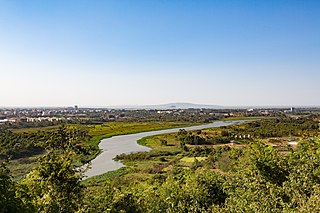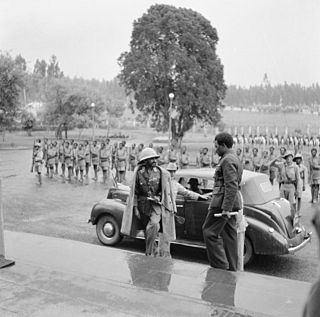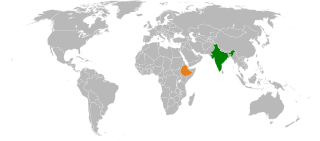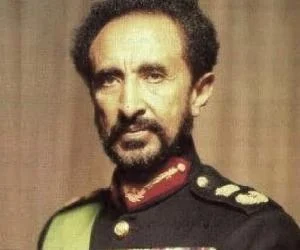
The foreign relations of Ethiopia refers to overall diplomatic relationship of Ethiopia. The Ministry of Foreign Affairs oversees foreign relations and diplomatic missions of the country.

Addis Ababa is the capital and largest city of Ethiopia. In the 2007 census, the city's population was estimated to be 2,739,551 inhabitants. Addis Ababa is a highly developed and important cultural, artistic, financial and administrative centre of Ethiopia.

Ethiopia, officially the Federal Democratic Republic of Ethiopia, is a landlocked country located in the Horn of Africa. It shares borders with Eritrea to the north, Djibouti to the northeast, Somalia to the east and northeast, Kenya to the south, South Sudan to the west, and Sudan to the northwest. Ethiopia has a total area of 1,100,000 square kilometres. As of 2022, it is home to around 113.5 million inhabitants, making it the 13th-most populous country in the world, the 2nd-most populous in Africa after Nigeria, and the most populated landlocked country on Earth. The national capital and largest city, Addis Ababa, lies several kilometres west of the East African Rift that splits the country into the African and Somali tectonic plates.

Addis Ababa University (AAU) is a national university located in Addis Ababa, Ethiopia. It is the oldest university in Ethiopia. AAU has thirteen campuses. Twelve of these are situated in Addis Ababa, and one is located in Bishoftu, about 45 kilometres (28 mi) away. AAU has several associated research institutions including the Institute of Ethiopian Studies. The Ministry of Education admits qualified students to AAU based on their score on the Ethiopian University Entrance Examination (EUEE).

Bahir Dar is the capital city of Amhara Region, Ethiopia. Bahir Dar is one of the leading tourist destinations in Ethiopia, with a variety of attractions in the nearby Lake Tana and Blue Nile river. The city is known for its wide avenues lined with palm trees and a variety of colorful flowers. In 2002, it was awarded the UNESCO Cities for Peace Prize for addressing the challenges of rapid urbanization.

Nekemte, also spelled as Neqemte, is a market town and separate woreda in western Ethiopia. Located in the East Welega Zone of the Oromia Region, Nekemte has a latitude and longitude of 9°5′N36°33′E and an elevation of 2,088 meters.

The Ethiopian Catholic Church is a metropolitan sui iuris Eastern particular church within the Catholic Church, established in 1930 in Ethiopia.

The history of Addis Ababa, capital of Ethiopia, formally begins with the founding of the city in the 19th century by Ethiopian Emperor Menelik II and his wife Empress Taytu Betul. In the Middle Ages, Addis Ababa depicted as a fortified city named "Barara", and served as residence of Emperor of Ethiopian Empire until Dawit II. It was totally plundered by Adalite general Ahmed Gran in 1529, at the onset of Ethiopian–Adal War.

Ethiopia is one of the oldest countries in Africa; the emergence of Ethiopian civilization dates back thousands of years. Due to migration and imperial expansion, it grew to include many other primarily Afro-Asiatic-speaking communities, including Amhara, Oromos, Somalis, Tigray, Afars, Sidama, Gurage, Agaw and Harari, among others. One of the first kingdoms to rise to power in the territory was the kingdom of D'mt in the 10th century BC, which established its capital at Yeha. In the first century AD the Aksumite Kingdom rose to power in the Tigray Region with its capital at Aksum and grew into a major power on the Red Sea, subjugating Yemen and Meroe. In the early fourth century, during the reign of Ezana, Christianity was declared the state religion. Ezana's reign is also when the Aksumites first identified themselves as "Ethiopians", and not long after, Philostorgius became the first foreign author to call the Aksumites Ethiopians. The Aksumite empire fell into decline with the rise of Islam in the Arabian peninsula, which slowly shifted trade away from the Christian Aksum. It eventually became isolated, its economy slumped and Aksum's commercial domination of the region ended. The Aksumites gave way to the Zagwe dynasty, who established a new capital at Lalibela before giving way to the Solomonic dynasty in the 13th century. During the early Solomonic period, Ethiopia went through military reforms and imperial expansion that allowed it to dominate the Horn of Africa. Portuguese missionaries arrived at this time.

Ethiopia–Israel relations are foreign relations between Ethiopia and Israel. Both countries re-established diplomatic relations in 1992. Ethiopia has an embassy in Tel Aviv. Israel has an embassy in Addis Ababa. Israel has been one of Ethiopia's most reliable suppliers of military assistance, supporting different Ethiopian governments during the Eritrean War of Independence.

Vilakuvelil Cherian Samuel (1912–1998), called Samuel Achen was an Indian Christian philosopher, scholar, university professor, theologian, historian, polyglot and ecumenical leader. He was a priest of the Indian Orthodox Church. He was the author of many doctrinal books and papers including The Council of Chalcedon Re-Examined: Historical Theological Survey.
The Argobba are an ethnic group inhabiting Ethiopia. A Muslim community, they are spread out through isolated village networks and towns in the north-eastern and eastern parts of the country. Group members have typically been astute traders and merchants, and have adjusted to the economic trends in their area. These factors have led to a decline in usage of the Argobba language. Argobba are considered endangered today due to exogamy and destitution.

Italians of Ethiopia are Ethiopian-born citizens who are fully or partially of Italian descent, whose ancestors were Italians who emigrated to Ethiopia starting in the 19th century during the Italian diaspora, or Italian-born people in Ethiopia.

Italian Ethiopia, also known as the Italian Empire of Ethiopia, was the territory of the Ethiopian Empire which was occupied by Italy for approximately five years. Italian Ethiopia was not an administrative entity, but the formal name of the former territory of the Ethiopian Empire which now constituted the Governorates of Amhara, Harar, Galla-Sidamo, and Scioa after the establishment of Italian East Africa.
Many changes were made during the reign of Haile Selassie toward the modernization of Ethiopia upon his accession as Emperor on 2 November 1930, as well as before, beginning from the time he effectively controlled Ethiopia in 1916 as Regent Plenipotentiary, Ras Tafari.

Ethiopia–India relations have existed for almost two millennia. Modern diplomatic relations between India and Ethiopia were established at the level of legations in July 1948, after the independence of India. The relationship was raised to the ambassadorial level in 1952. India maintains an embassy in Addis Ababa and Ethiopia in New Delhi. The two countries have enjoyed close and friendly relations with India supporting Ethiopian developmental efforts while Ethiopia has supported Indian interests such as its claim to a permanent seat on the United Nations Security Council. India and Ethiopia share a common understanding on such issues as cross-border international terrorism, the need and direction for reform of the United Nations, and the importance of action on climate change.
The following is a historical events of Addis Ababa, the capital of Ethiopia, including its formation prior to 20th century by chronology.

Ethiopia–Spain relations are the bilateral and diplomatic relations between these two countries. Ethiopia has no embassy in Spain, but the Ethiopian embassy in Paris is accredited to Spain. Ethiopia has an honorary consulate in Madrid. Spain has an embassy in Addis Ababa.

Opposition to Haile Selassie relied largely of internal administration of his country. While Haile Selassie made attempt to modernize the country and brought to global power since Italy's occupation in 1936–41, the later administration met with negative public attitude especially among educated people in universities and peasants.

Higher education in Ethiopia is the lowest in quality of standard relevance and academic freedom, despite an expansion of private higher education and rising enrollment. Higher education supposed originated by Saint Yared music school in the sixth century in line with centuries old traditional education of the Ethiopian Orthodox Tewahedo Church. Modern higher education was commenced during the reign of Emperor Haile Selassie with the establishment of the University College of Addis Ababa, now called Addis Ababa University in 1950. It then followed by Haramaya University. By the time, there were only three secondary schools in the country, used as preparatory for college entrance.


















